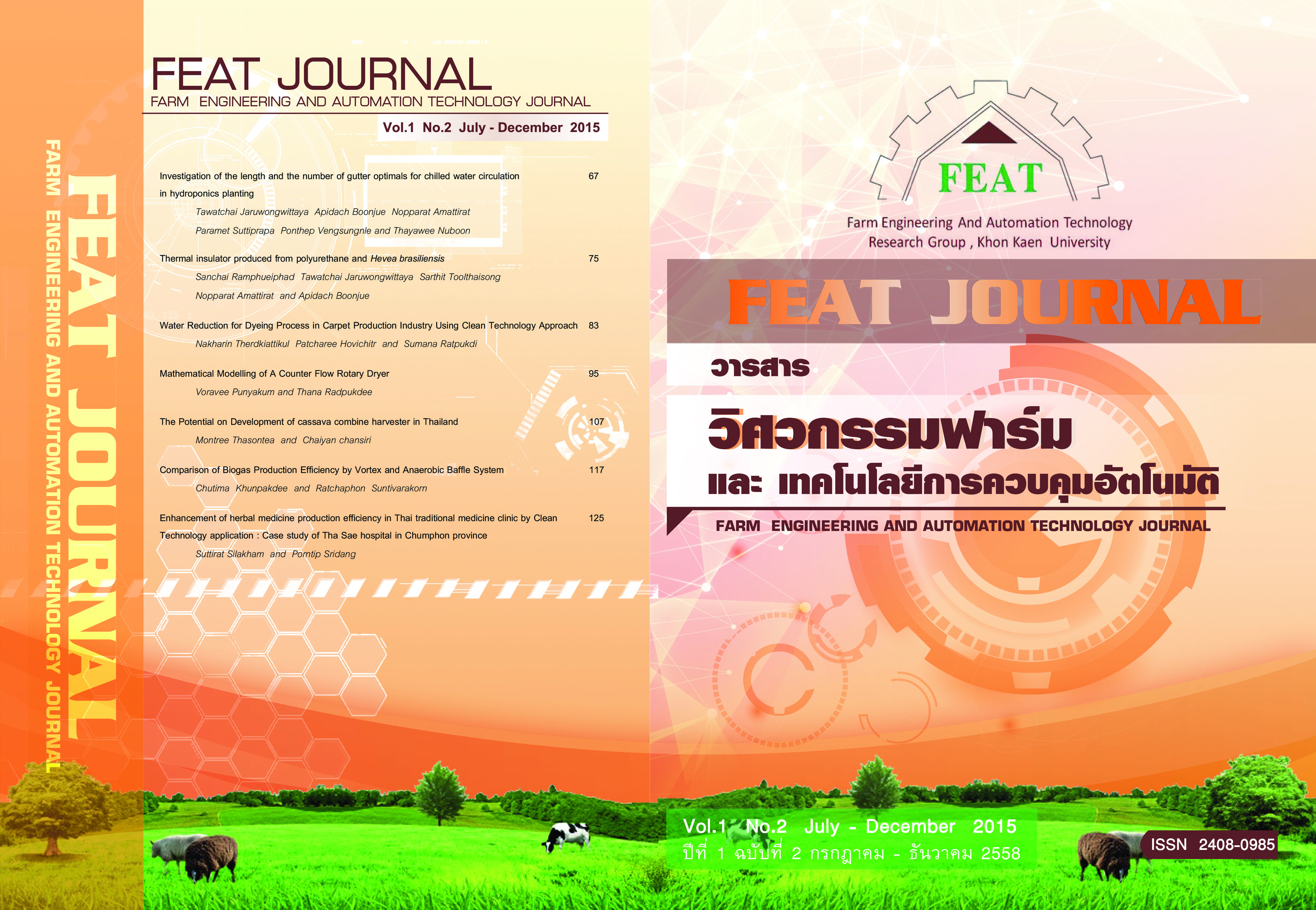ฉนวนยางพาราผสมโพลียูรีเทน
Main Article Content
บทคัดย่อ
งานวิจัยนี้มีวัตถุประสงค์เพื่อศึกษาค่าการนำความร้อนและอัตราการลามไฟของฉนวนความร้อน โดยนำโพลียูรีเทน โฟมมาย่อยเป็นชิ้นเล็กๆ และนำส่วนผสมน้ำยางพารากับบอแร็กซ์ซึ่งทำหน้าที่เป็นตัวประสานมาผสมเข้ากับเส้นใยโพลียูรีเทนโฟมเพื่อขึ้นรูปเป็นแผ่นฉนวน ตากแดดเพื่อไล่ความชื้นจนแห้ง ผลการทดสอบหาค่าการนำความร้อนและอัตราการลามไฟ พบว่าค่าการนำความร้อนสูงขึ้นเมื่อความหนาแน่นของแผ่นฉนวนสูงขึ้นโดยความหนาแน่นที่อัตราการลามไฟต่ำสุดอยู่ที่ 190.05 kg/m3 จากการทดสอบได้ค่าการนำความร้อนเฉลี่ย 0.048 W/m K และอัตราการลามไฟอยู่ระหว่าง 1-3 mm/min
Article Details
วารสารวิศวกรรมฟาร์มและเทคโนโลยีควบคุมอัตโนมัติ (FEAT Journal) มีกําหนดออกเป็นราย 6 เดือน คือ มกราคม - มิถุนายน และกรกฎาคม - ธันวาคม ของทุกปี จัดพิมพ์โดยกลุ่มวิจัยวิศวกรรมฟาร์มและเทคโนโลยีควบคุมอัตโนมัติ คณะวิศวกรรมศาสตร์มหาวิทยาลัยขอนแก่น เพื่อเป็นการส่งเสริมและเผยแพร่ความรู้ ผลงานทางวิชาการ งานวิจัยทางด้านวิศวกรรมศาสตร์และเทคโนโลยีพร้อมทั้งยังจัดส่ง เผยแพร่ตามสถาบันการศึกษาต่างๆ ในประเทศด้วย บทความที่ตีพิมพ์ลงในวารสาร FEAT ทุกบทความนั้นจะต้องผ่านความเห็นชอบจากผู้ทรงคุณวุฒิในสาขาที่เกี่ยวข้องและสงวนสิทธิ์ ตาม พ.ร.บ. ลิขสิทธิ์ พ.ศ. 2535
References
[2] Thitithammawong A. Oil and Heat Resistance, Flame Retardant Natural Rubber from Chlorinated Epoxidized. [Research Report]. Pattani: Prince of Songkla University; 2009. (In Thai).
[3] Wimolmala E. Effects of Coating Thickness and TiO2 Dosage in Polyurethane Coating on Heat Transfer Properties of Wood-Natural Rubber Roofs. Proceedings of the 11th Graduate Research Conference ; 2010.(In Thai).
[4] Buasri K. The Production of Thermal Insulation Boards form Rice Straw. [MSc thesis]. Bangkok: King Mongkuts University of Technology Thonburi; 2001. (In Thai).
[5] Bunmemapasuk T. Manufacture of Flame Retardant and Insulation Sheets From Water Orchid Fiber and Natural Rubber. [MSc thesis]. Major Field: Safety Engineering, Interdisciplinary GraduateProgram. Kasetsart University. Bangkok ; 2006. (In Thai).
[6] Pakunworakij T. Thermal Resistance Efficiency of Building Insulation Material from Agricultural Waste. Journal of Architectural /Planning Research and Studies. 2006;4(1): 1-13. (In Thai).

